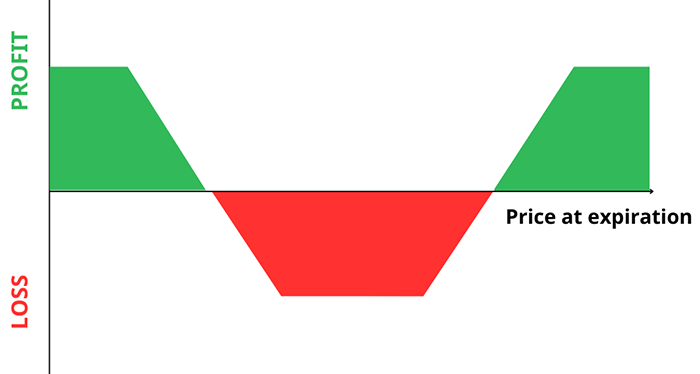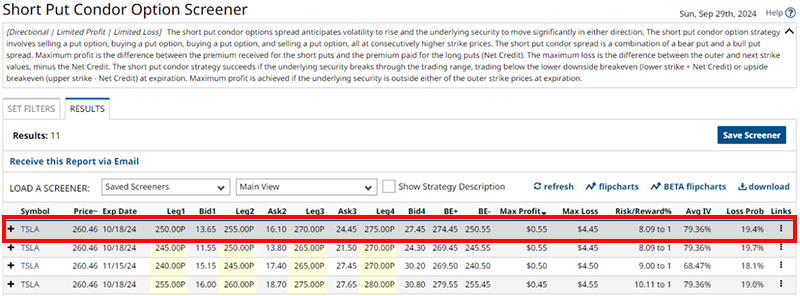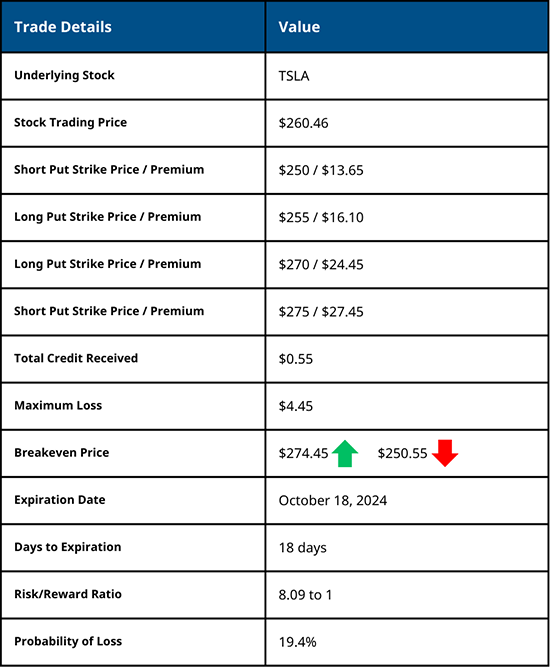Short Put Condor Option Screener
Short Put Condor Option Screener
Hi, and welcome to the Options Learning Center. I'm going to show you how to sell short put condors and use Barchart to get the most out of the strategy.
What is a Short Put Condor?
A short put condor is a directional options trading strategy that involves buying and selling put options at progressively higher strike prices for the same underlying asset, with the same expiration date. This strategy combines a bear put spread and a bull put spread, and it works best when significant price movement in either direction is expected.

Short Put Condor Options Strategy:
- Directional Strategy
- Four Put Options
- Same Underlying Asset & Expiration
- Result: Bear Put & Bull Put Spread
- Profit: Asset Price Moves Beyond Short Strikes
- Max Profit: Net Credit
- Loss: Underlying Asset Trades Between Long Strikes
To setup the trade, you’ll sell an in-the-money put at one strike, then buy a put at a higher strike, buy another at an even higher strike, and finally, sell a put at the highest strike.
Trade Setup:
- Sell a Put: Lowest strike price.
- Buy a Put: At a higher strike price.
- Buy a Put: At an even higher strike price.
- Sell a Put: At the highest strike price.
The result is a combination of a bear put and bull put spread that creates a short put condor, resulting in a net credit. The goal is for the asset price to either move below the lower short strike, or above the higher short strike, which will result in maximum profit. Maximum loss occurs if the asset price trades within the long strikes.
Screening The Market For Short Put Condor Trades
To access the Short Call Condor screener, go to Barchart.com, click on the Options tab, and then click on Short Put Condor Screener. This will immediately bring you to the Results page, where several potential short put trades are already displayed. There’s important information about the trades including strike prices and premiums, max profits, losses, risk/reward ratios, and loss probability.
You can click any of these headings to arrange them from highest to lowest or vice versa, depending on your preferences. The results here are a great starting point for trading, but if you want to fine tune your screen, look for the Set Filters tab at the top. Once you click that, you will be brought to the options screening page, where several default filters and values are already in place for short put condor trades.
If you want to add filters, you can easily do that by clicking in the Add a Filter field, typing in your preferred filter, then click Add. If you're not sure what filter you're looking for, you can also click the dropdown to choose from dozens of other filters.
To delete any of the filters, click the checkbox next to them and then click Delete. The default filters provide a healthy balance of opportunities. Of course, you can expand the search by adding in weekly expirations and ETFs.
Now, I'll scroll down to the bottom where I'll find the Probability of Loss filter. As the name suggests, this filter shows the chance of the short put condor trade ending at a loss, even by one cent. The lower the probability of loss, the lower the potential profit and the higher the potential dollar loss value. But, since short put condors have inherently high risk/reward ratios, I’ll take my chances on a safer trade and set this to 20%.
Now, click See Results, and click the Max Profit column to sort.
Before we discuss the trade, you can save your screener so you can reuse it later. You can also have Barchart email you at a specified time with your trades. Just click Save Screener near the top right, then type in a name for the screener, click on when you want the email to arrive, then click Save.
Let's move on to the trade example:

The top of the list is a short put condor on Tesla. The stock currently trades at $260.46. To make the trade, you’ll sell a $250-strike put for $13.65 per share and buy a $255-strike put for $16.10 per share.
You’ll also buy a $270-strike put for $24.45 per share and sell a $275-strike put for $27.45 per share. This setup results in a net credit of $0.55 per share, or $55 total, while your maximum loss is $4.45 per share. The trade has an 8.09 to 1 risk-to-reward ratio, with a 19.4% probability of loss. All options expire on October 18, 2024, 18 days from the date of recording.
To calculate the breakeven points, add the net credit to the lowest strike price for the downside, which makes it $250.55. On the upside, take the highest strike price and subtract the net credit, resulting in $274.55.

Breakeven Calculation:
- Downside: Lowest put strike plus the premium received.
- Upside: Highest put strike minus the premium received.
Now that we have our trade details, let’s see how the trade can go.
Profit Scenario

If the price of Tesla stock trades below the lower short strike, or above the higher short strike at expiration, you get the maximum profit. Again, the maximum profit for any short spread is the net credit received at the start, which, in this case, is $0.55 a share or $55 per contract.
Credit Received: ($27.45 + $13.65) - ($24.45 + $16.10)
Credit Received: $41.10 - $40.55 = $0.55 * 100 = $55
Loss Scenario

On the other hand, if Tesla’s stock trading price fails to move beyond the long strike prices by expiration, the trade will end at a maximum loss. To calculate the maximum loss, take the net credit received and subtract the width of one side of the spread. For this trade, it’s $4.50 a share or $450 per contract.
Width Of The Spread: $255 - $250 = $5
Net Credit Received: $0.55
Maximum Loss: $0.55 - $5 = -$4.50
Profit/Loss Scenarios Across Different Price Points
Here’s the profit/loss table at different price points to give you a better idea of how this short put condor works.

Notice how the trade only starts to profit when the stock trades below the lower short strike and above the higher short strike? And losses occur when the stock trades between the long strikes. The range between the short and long strikes will result in partial losses, which is why knowing your breakeven points is important.
Screening For Short Put Condors With Specific Assets
So far, you've learned how to scan the market for short call condor trades. But what about if you have a specific stock in mind? That's also easy. Let me show you how.
All you need to do is go to the stock or asset's Price Overview page on Barchart.com. Once there, look for Condor Strategies. Then look for the Short Put Condor tab. From here, you can change expiration dates, change trade legs, rearrange each column, or click the screen button to reach the option screener page for a more granular search. That's it!
Closing Your Positions Before Expiration
Options trading comes with assignment risk if a short option is in the money. So, any trade that involves writing or selling options puts you at risk of assignment. For the short put condor, you have two short positions in this trade, and if either of them is in the money by expiration, the option will be automatically exercised, or, in your perspective, you will be assigned. That’s why it’s best to close out your trade right at or before expiration.
- Close Short Positions Before Expiration
- Avoid Automatic Assignments
- Two Short Positions at Risk
Pros and Cons
Short put condors, like all spread strategies, have limited risks and a well-defined trading profile that you can calculate at the start of the trade. It is also ideal to use during times of higher volatility. Lastly, setting it up results in a net credit at the start of the trade.
Pros:
- Limited Risk
- Defined Trade
- Ideal For High-Volatility Trades
- Net Credit Trade
However, like all spreads, it has limited profit potential. The trade also requires four working trade legs, which can be complex for beginners. And on the subject of those trade legs, each of them comes with a corresponding trading fee from your broker, making it potentially costly to set up. Lastly, the strategy has two short positions that may be open to the risk of assignment.
Cons:
- Limited Profit Potential
- Complexity
- Trading Fee Costs
- Risk of Assignment
Conclusion
The short put condor trade can be a great strategy in times when markets are experiencing significant price swings in either direction. However, it comes with its own drawbacks, especially the high trading costs and risk of assignment. That’s why it’s important to maximize your chances of success and using resources like stock information websites and options screeners.
If you'd like more information, visit the Barchart Options Learning Center, where you can learn more about all the other options trading strategies, how they work, and how to profit from each.
Back to Top ↑
